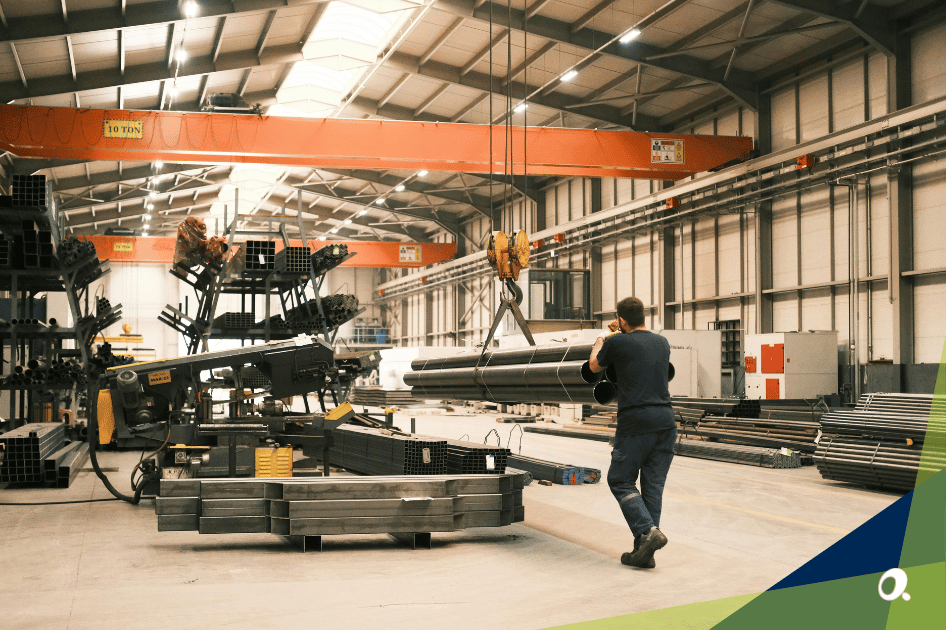Slow order fulfilment isn’t just a logistics issue. See how real-time fleet visibility can uncover hidden inefficiencies in your hire operations.
When you can’t get equipment out the door fast enough, the impact hits every part of your business. Customers lose confidence, projects get delayed, and your team ends up firefighting instead of moving smoothly from order to delivery. Speed isn’t just a nice-to-have in equipment hire anymore — it’s a competitive advantage.
Research shows that 23% of customers won’t return after a delayed delivery. Although that figure comes from the wider logistics sector, the principle is the same: delays damage trust. If a machine isn’t where it needs to be, when it needs to be there, that trust is difficult to win back.
A major reason for these delays is a lack of visibility. When you don’t know exactly where your assets are, what’s available, or what’s being maintained, it’s hard to deliver on time. This article looks at how real-time fleet visibility gives you the clarity to speed up fulfilment, strengthen customer trust, and build a more efficient operation.
What Real-Time Fleet Visibility Means
Real-time fleet visibility is the ability to see exactly where your equipment is, what’s available, and what’s being used — the moment it happens. It gives you a live view of your fleet so you can make confident, fast decisions without chasing down information from different teams.
Core components of fleet visibility
Effective visibility usually brings together a few key elements:
Live asset tracking – knowing where each piece of equipment is at any given time.
Availability and utilisation data – seeing which assets are booked, idle, or under maintenance.
Maintenance status – avoiding unplanned downtime by staying ahead of servicing.
Operational dashboards – centralising everything so you’re working from one source of truth.
This level of clarity helps you stay proactive rather than reactive.
Manual tracking vs. real-time tracking
Manual Tracking | Real-Time Tracking |
|---|
Information lives in spreadsheets, emails, or phone calls | Information updates automatically in one dashboard |
Easy for data to go out of date | Always up to date with live equipment status |
High risk of double booking or delays | Instant visibility into availability and utilisation |
Slow response times | Faster allocation and smoother fulfilment |
Heavy reliance on individual team members | Shared, accurate data accessible to everyone |
Real-time visibility gives you control and certainty. You know exactly what’s happening with your assets — and you can act on it immediately.
How Lack of Visibility Slows Order Fulfilment

When you don’t have a clear view of your fleet, every decision takes longer. Your team ends up reacting to problems instead of getting ahead of them. That slows fulfilment, creates unnecessary costs, and frustrates both staff and customers.
Common operational bottlenecks
Unreliable availability data – Assets that seem ready to go may already be in use or awaiting maintenance.
Last-minute surprises – Unplanned downtime disrupts delivery schedules and leaves little room to adjust.
Poor coordination – When operations, finance, and logistics rely on different sources of information, even small gaps can cause major delays.
Real-world impact
Imagine a customer books a scissor lift for a time-sensitive job. The system shows it as available, but it’s actually still on another site. The delivery window is missed, the project stalls, and your team spends the rest of the day fixing an issue that better visibility could have prevented.
How Real-Time Visibility Speeds Up Fulfilment
Real-time visibility gives your team the clarity to act fast. Orders are processed with fewer delays, assets move where they’re needed without confusion, and customers get their equipment on time. That level of control turns fulfilment from a reactive scramble into a smooth, predictable process.
- Faster asset allocation
Live utilisation data makes it easy to see which assets are genuinely available, which are already booked, and which are under maintenance. That clarity helps your team assign equipment to the right job straight away — without phone calls, spreadsheets, or second-guessing. Fewer delays also mean fewer costly workarounds and less wasted time across teams.
- Reduced lead times
Clear insight into availability and location means equipment moves out the door faster. Meeting delivery slots not only strengthens customer trust but also cuts down on the operational costs tied to missed windows and rescheduling.
- Stronger operational coordination
Everyone works from the same information — finance, operations, logistics, and dispatch. That shared visibility removes guesswork and keeps the fulfilment process moving at pace. Fewer errors and less duplication naturally reduce overheads, helping you run leaner operations.
The Business Benefits of Fleet Visibility

Faster fulfilment is only one part of the story. Real-time visibility creates ripple effects that strengthen every part of your operation — from how you serve customers to how efficiently your team works. These benefits add up to a stronger bottom line and a more predictable business.
Customer and revenue impact
Clear visibility allows you to meet delivery commitments consistently. Customers are more likely to return when the equipment arrives on time and in the right condition. Reliable service drives repeat business, stronger relationships, and higher lifetime value.
Operational efficiency gains
Idle assets cost money. When you know exactly what’s in use and what isn’t, you can plan more effectively, reduce downtime, and make better use of your fleet. That translates into fewer bottlenecks, lower handling costs, and better use of your team’s time.
Financial performance
Speeding up fulfilment shortens the gap between order and invoice. That means improved cash flow, more predictable revenue, and fewer administrative delays. Clear operational data also gives your finance team the visibility they need to plan confidently and allocate resources effectively.
Technologies Enabling Real-Time Visibility
You can’t achieve real-time visibility without the right technology behind it. Spreadsheets and phone calls only take you so far — they don’t give you the accuracy or speed your business needs to keep up. Modern tools close that gap by giving you live, reliable data that everyone can act on.
Core tools
GPS and telematics – Track the exact location of assets and monitor movement in real time.
IoT sensors – Flag maintenance issues early and help prevent downtime before it happens.
Cloud dashboards – Bring all operational data together so your team sees the same information at the same time.
Why integration matters
Technology works best when your operational data connects with your financial systems. A single source of truth eliminates silos, improves accuracy, and removes the manual work that slows everything down.
For example, Sage Intacct can bring operational and financial data together in one place — no more reconciling spreadsheets, chasing team updates, or waiting on information that should already be at your fingertips.
How Finance Leaders Benefit Directly

Operational visibility isn’t just useful for dispatch or warehouse teams. When finance leaders have access to the same live data, they can make decisions faster and with far more confidence. It removes the delays caused by manual reporting and gives your business a much clearer financial picture.
Better forecasting and planning
In equipment hire, demand often shifts with seasonal demand trends, project timelines, or market conditions. Real-time utilisation data helps you spot those patterns early, so you can plan fleet availability, capital investment, and workforce allocation more accurately. That forward view turns what used to be reactive planning into informed decision-making.
Faster order-to-cash cycle
The fewer delays in fulfilment, the faster invoices can go out. That improves cash flow, reduces aged debt, and gives you better visibility over working capital.
Clearer asset ROI
It’s easier to understand how well your assets are performing when utilisation data and financial data live in the same place. That visibility helps you plan maintenance, decide when to replace equipment, and allocate capital more effectively.
Signs Your Fleet Tracking System Is Holding You Back
A lack of visibility doesn’t always show up overnight. It creeps in slowly — through missed delivery slots, duplicated work, and frustrated teams trying to make sense of messy data. If these signs sound familiar, your tracking system may be part of the problem.
No real-time updates on asset location or status, making it harder to plan accurately
Frequent double bookings or scheduling conflicts that increase operational costs
Unexplained delivery delays that damage customer confidence and slow invoicing
Growing invoicing backlogs that affect cash flow and revenue forecasting
Heavy reliance on manual spreadsheets and phone calls, adding time and risk to every order
Limited insight into utilisation or maintenance patterns, making it difficult to maximise ROI
Spotting these early gives you the chance to fix them before they become costly habits.
Building a Real-Time Visibility Strategy
Strong visibility doesn’t just fall into place on its own. It takes a clear plan to connect people, systems, and information in a way that actually works day to day. A simple, structured approach helps you close the gaps slowing you down and build a setup that supports your business as it grows.
Here’s an example of what you can do:
Step 1: Audit your current operations
Begin by identifying where delays and data gaps occur. Look at how information is shared between teams, where manual work is slowing things down, and where visibility breaks down.
Step 2: Identify integration gaps
Once you know where the weak points are, assess how your current systems connect. If operational and financial data live in separate places, it’s much harder to make fast, informed decisions.
Step 3: Choose scalable technology
Investing in tools that provide real-time tracking and accurate reporting gives your team the clarity they need. Scalable systems ensure that visibility doesn’t fade as your fleet and customer base grow.
Step 4: Train teams to use it effectively
Even the best tools won’t make a difference if people aren’t confident using them. Make training and clear processes part of the rollout so everyone works from the same reliable data. And that’s where the right implementation partner can make the difference.
See how Accord can help you
Visit our Services page
Conclusion
Faster fulfilment starts with better visibility. When you can see what’s happening across your fleet in real time, you remove the delays, guesswork and extra costs that slow your business down.
Strong operational visibility gives you more control, more confidence and a clearer financial picture. It strengthens customer trust and sets the foundation for long-term growth.
If improving fleet visibility is on your radar, the right strategy and technology can help you get there faster.
Book your free Discovery Call here
Real-Time Fleet Visibility FAQs
- What is real-time fleet visibility in equipment hire?
Real-time fleet visibility means having live, accurate information on where your assets are, what’s available, and what’s in use. It allows your team to make fast, informed decisions without relying on outdated spreadsheets or fragmented updates.
- How does real-time visibility reduce order fulfilment time?
When everyone can see the same up-to-date information, assets can be allocated faster and deliveries are less likely to be delayed. It removes the guesswork that slows down fulfilment.
- What technologies are commonly used for fleet tracking?
GPS, telematics, IoT sensors and cloud-based dashboards are the main tools used to track equipment in real time. The growing telematics adoption in equipment hire, for example, makes it easier to collect live data, monitor asset performance and act on issues before they cause delays.
- Who benefits most from improved visibility?
Both operations and finance teams benefit. Operations teams can work more efficiently, while finance leaders gain more accurate forecasting, faster invoicing and clearer insight into asset performance.
- How can a business start improving its fleet visibility?
Begin by reviewing how information currently flows across your business. Identify the gaps, look for ways to integrate operational and financial data, and invest in technology that gives your team live, reliable information.